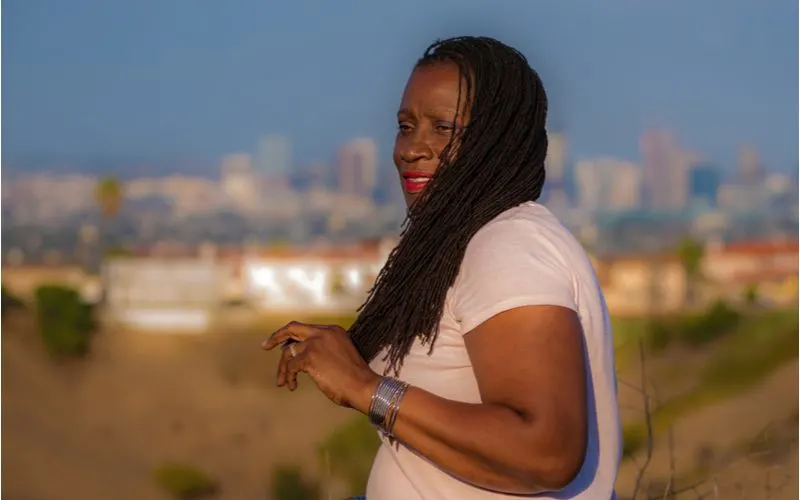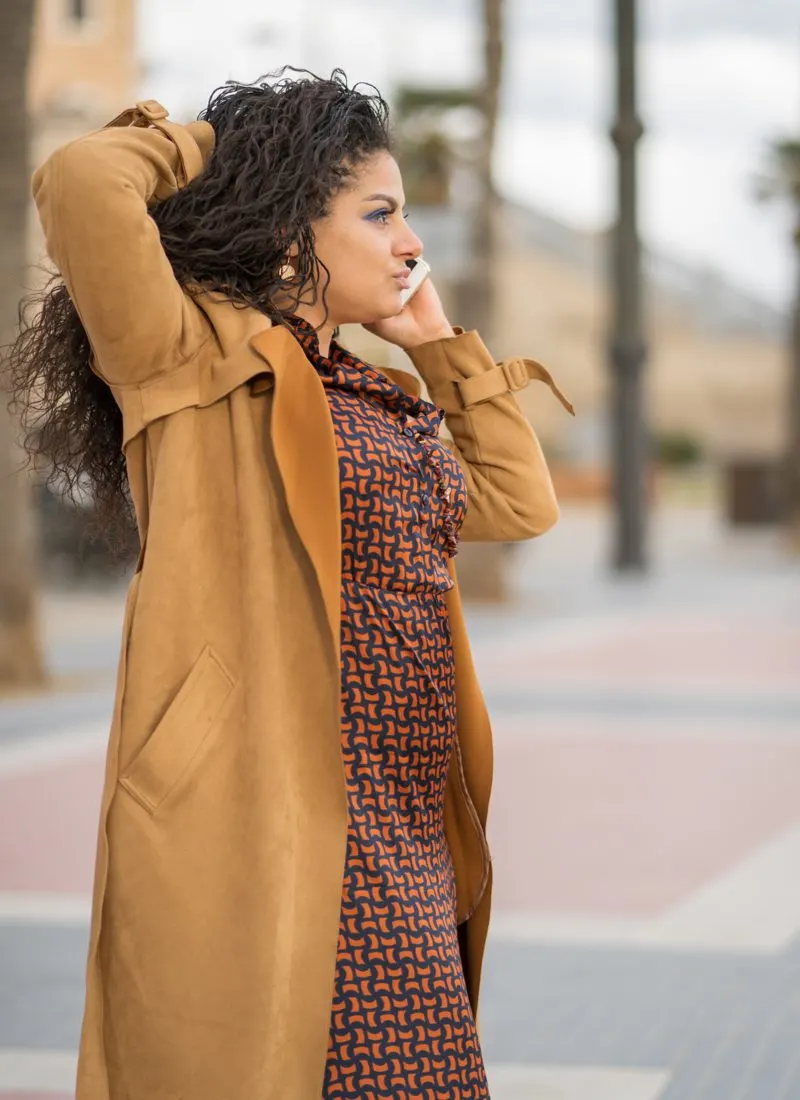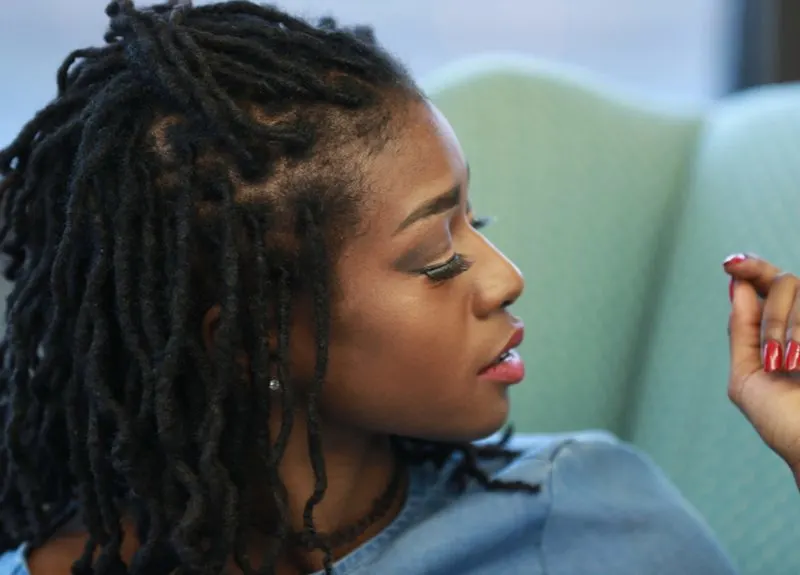Jump to:
Sisterlocks are the skinnier, more versatile version of dreadlocks. But should you rock them? Find out everything you need to know about this protective style and see 12 different ways to wear them in our style guide!
Thinking About Growing Sisterlocks?
If you’re looking for a protective style that won’t cramp your style, sisterlocks are a great option. These thin dreadlocks are different from traditional locs and are the preferred style for many women with natural kinky or coily hair.
What makes sisterlocks so special? Is this the right protective style for you? What are the best ways to style them?
We’ve got all the answers you’re looking for right here in our style guide. Keep reading to learn about this popular hairstyle that is universally flattering and easy to style and maintain.
What Are Sisterlocks?
Sisterlocks are skinny dreadlocks formed with a special interlocking tool instead of rolling or twisting (common techniques to form traditional dreadlocks).
Dr. JoAnne Cornwell developed them in 1993 when she determined black women needed a hair-healthy styling option that didn’t involve the use of chemical relaxers or hair extensions.
She also created brotherlocks – a slightly thicker version that are typically styled on men’s hair.
Sisterlocks are created from the ends of the hair up toward the roots, unlike dreadlocks. The use of a proprietary interlocking tool is part of what makes them special.
The Sisterlocks™ tool pokes through the hair and allows you to pull the loc through the opening to keep them tight and to contain new growth at the roots. Only trained consultants and people who take an online self-retightening course can purchase the original Sisterlocks™ tool.
It’s considered one of the best interlocking tools in the industry and if you plan to re-tighten your locs at home for maintenance, you’ll want to look into taking the re-tightening course and grabbing this tool for yourself.
If you’re sticking to a budget, other interlocking tools are widely available online.
However, as Digital Loctician warns, cheap tools can easily snag your hair and increase the odds of traction alopecia. This is a type of baldness that occurs from repeated tension on the scalp with tight hairstyles like locs or braids.
Sisterlock Benefits
If you’re thinking about trying out this protective hairstyle for women, you’ll be glad to know that there are several benefits associated with these locs. Here’s why this style is so popular for women with naturally kinky and coily hair.
- Professional quality: While DIY dreadlocks are common, sisterlocks are typically done by a trained professional (called a consultant) who is highly experienced and skilled in the special interlocking technique. By going to a trained pro, you’re going to get a better, more professional-level quality with sisterlocks.
- Universally flattering: This type of loc is smaller in circumference than traditional dreadlocks, so it’s a better fit for most womens’ faces. Women’s faces are usually smaller with softer features than men, so it makes sense that skinnier, more precise locs would be a better fit for women.
- Low maintenance and protective: Sisterlocks are a protective style that is also very low-maintenance. While in the locs, your hair growth will be unimpeded and many women report that their hair grows faster while it’s locked up. With less daily styling and manipulation, your hair will suffer less breakage and other types of damage. Daily styling is 100% optional with this type of loc because it is a style in itself.
- Looks like free-flowing hair: For women who don’t like the chunky look of traditional dreadlocks, the sisterlock variety is a much better fit. They almost resemble loose, free-flowing hair because each individual loc is so skinny.
- Great natural hairstyle: Women who prefer avoiding chemical relaxers and extensions are big fans of this type of loc because it doesn’t require anything “fake.” You can have faux sisterlocks installed, but many opt for this style because it’s such a beneficial protective style for their natural hair.
12 Ways to Style Sisterlocks
Sisterlocks are clearly a favorite protective natural hairstyle with a lot of benefits, but is it going to be the right choice for you? Start by taking a look at some of the different ways you can style this versatile type of dreadlock.
Long Sisterlocks With Deep Side Part

Ansel B/Shutterstock
These are the quintessential sisterlocks – long, thin, and resembling free-flowing hair. This gives you the versatility needed to try out different types of styles when you wear your hair down or up. Here, a deep side part piles the volume up on top a bit and makes the hair look thicker at the roots.
Sisterlocks Space Buns

Kosim Shukurov/Shutterstock
There’s no shortage of fun hairstyles to try with your sisterlocks, especially once they reach past your shoulders. Try these funky space buns with lots of loose locs hanging out for a look that balances wild child with fashionista.
Sisterlocks High Ponytail

Prostock-Studio/Shutterstock
A high ponytail looks thicker because the height of the style allows the hair to cascade down and spread out. You can see how this simple-yet-polished style can be dressed up or down – this look would be just as fitting with a formal outfit as it is here!
Crochet Faux Sisterlocks

Flamingo Images/Shutterstock
Faux sisterlocks are an easier shortcut that is perfect for women who don’t want to wait and grow out their hair. It’s also better for those who aren’t quite ready to commit to an interlocked style like this. Faux versions are more uniform and easy to manage.
Read Next: Crochet Hair
Ultra-Long and Thick Sisterlocks

Phil Halfmann/Shutterstock
Whether you’re currently rocking super-long hair or want long extensions, wearing your hair in sisterlocks will make ultra-long styles so much more manageable. Try a high ponytail with the lengths draped over your shoulder like the model here!
Sisterlocks Bun With Side Bangs

Yurakrasil/Shutterstock
Pink highlights and braids worked into the bangs make these locs a unique and eye-catching choice. The best part is the freedom you have to switch things up to play around with different looks.
The placement of the locs means you can create a side part in the front to mimic bangs when you want to better frame your face with an updo.
Long Skinny Sisterlocks With Loose Ends

Dani Llao Calvet/Shutterstock
Sisterlocks are thinner than traditional dreads, but this version is ultra-skinny and more closely resembles loose hair. This makes them perfect for styling in down and loose styles or updos.
With so many skinny locs in the style, you can easily style each loc in waves or curls as shown to mimic free-flowing hair with the convenience and easier management of sisterlocks.
Half-Up Sisterlocks

Kosim Shukurov/Shutterstock
Pulling the top half (or a little less, as shown) up will sharpen your facial features for a leaner, defined look. This is a great way to style your locs to keep them out of your face without the weight of pulling them all into a ponytail. The added height on top is also the perfect style choice for women with a round or square face.
Loose Wavy Sisterlocks

Dragon Images/Shutterstock
These locs are much thinner than traditional dreadlocks, so they more easily mold into waves and curls for different looks. We love the beachy, casual vibe of these long and loose locs! Try winding your locs into coiled buns overnight to get pretty waves like this.
Jumbo Sisterlocks With Curly Ends

F8 Studio/Shutterstock
This style is thicker than most sisterlocks, earning it the jumbo name and making it a better choice for super-thick hair. The curly ends bring some bounce and movement to the style and present more styling opportunities so you never get bored with your locs!
Sisterlocks in High Ballerina Bun

Kosim Shukurov/Shutterstock
A high, polished bun works best with medium-length sisterlocks because they’re still relatively lightweight. This versatile style can work for any type of occasion from casual to formal.
The medium-thick locs shown are gorgeous with this updo style, but we think skinny locs would look just as nice.
Read Next: Easy Updos
Curly Side-Swept Sisterlocks

Kosim Shukurov/Shutterstock
Wearing your locs curly adds more texture to the style and helps you adopt some of the same styles you can do with free-flowing, loose hair.
The curls, created with two-strand twists, help the ends stand out and create cascading “layers” that gradually get longer when the hair is styled in a deep side part.
Things to Consider
See how amazingly versatile these locs can be? From mimicking loose, free-flowing hair to making everything from ponytails to updos easier and more manageable, sisterlocks are considered one of the best natural hairstyles for a reason.
But before you decide if they’re right for you, there are a few things you need to consider.
- They can be expensive. True sisterlocks have to be installed by a certified, trained consultant. It can be a challenge to find one in your area, and if you do, you’ll find that the installation can get pretty expensive. You could spend anywhere from $500 to $1,000 on installation and re-tightening, so if budget is a concern, this may not be the right choice.
- Installation takes time. Like dreadlocks, you can’t expect to get sisterlocks in one visit. Installation takes time – most installations take 2-3 days at the salon, or around 16-18 hours. After that, re-tightening the locs (if you don’t purchase a tool and learn to do it yourself) will take 3-5 hours of time every 4-6 weeks to keep them looking good.
- You have to be careful with moisture. Naturally kinky and coily hair is prone to moisture loss, so it’s worth considering that sisterlocks can’t be heavily moisturized within the first few weeks of installation. The interlocking technique that forms the locs is prone to coming undone if the hair is overly moisturized while the locs are new. If you have particularly dry hair or a dry scalp, you could run into problems here.
- It’s a commitment. Getting any type of loc is a major commitment because you’ll be wearing the same style for years if you don’t cut the hair or painstakingly comb them out. Sisterlocks can be even more of a commitment since the hair becomes so knotted and locked thanks to the interlocking tool used in their installation. Be sure that you’re willing to stick with this style for a long time before you invest the time and money in getting them!
Should You Get Sisterlocks?
All things considered, this protective hairstyle is still one of the best options for women. It’s versatile in terms of style possibilities because it so closely resembles and acts like free-flowing hair. It protects your hair, requires little day-to-day maintenance, and obviously looks great.
As long as you’re aware of the long-term commitment and have room in your budget, we think sisterlocks are the perfect hairstyle choice for women with textured natural hair.
We recommend having a professional, certified consultant install your locs and do the first re-tightening for you. Then, you can take the online course and learn how to tighten the locs yourself to save money in the long run and build your styling skill set!
